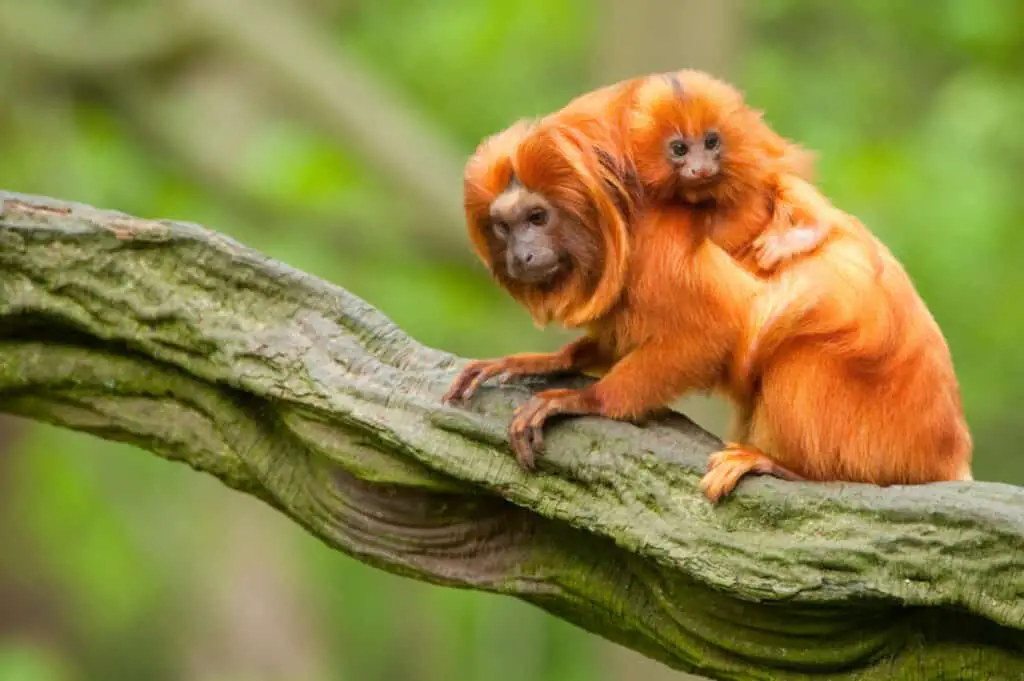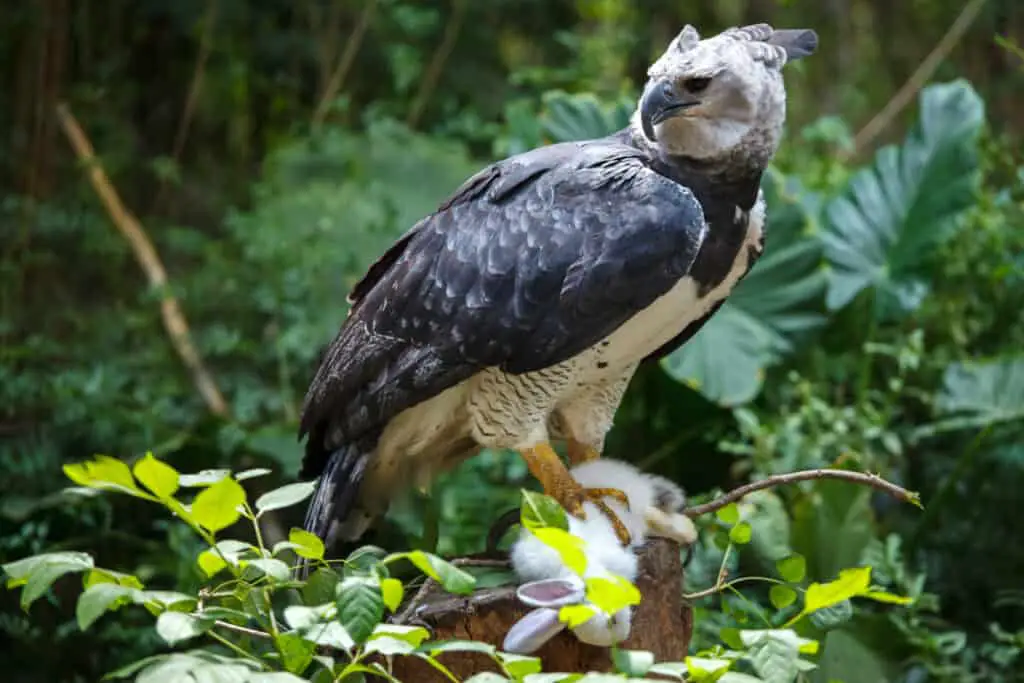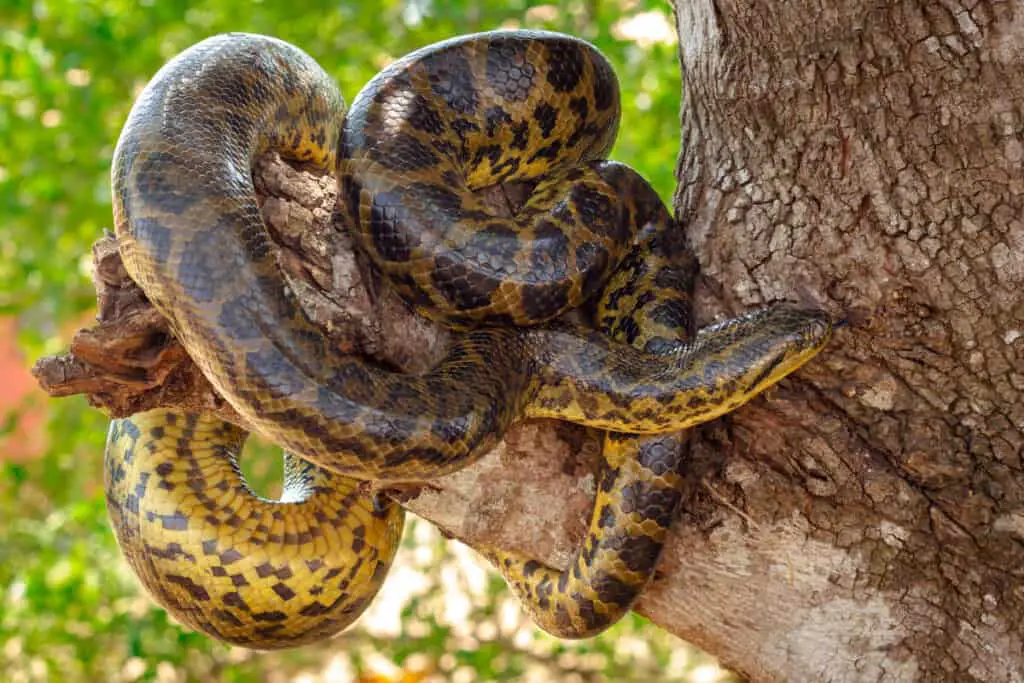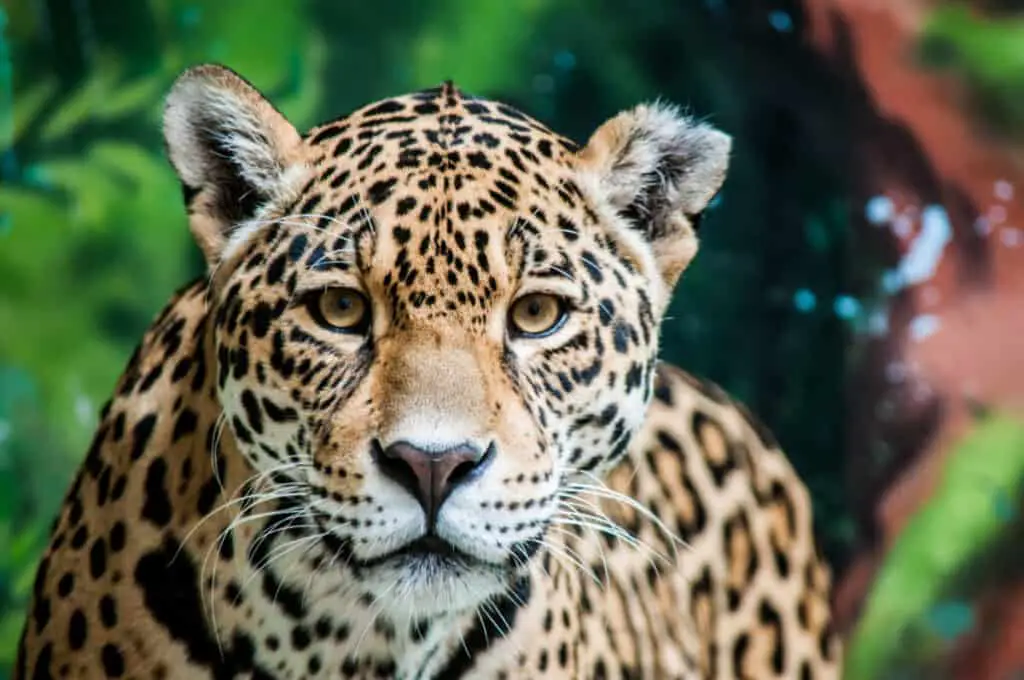Golden lion tamarins are small primates that inhabit the eastern regions of Brazil’s Atlantic coastal rainforest. These vibrant creatures are an endangered species, with only around 3,200 remaining in the wild due to habitat destruction and fragmentation caused by human activities.
Despite conservation efforts aimed at protecting their dwindling populations, golden lion tamarins face numerous threats from predators. Several animals prey on these tamarins throughout their range, including birds of prey such as hawks and eagles, snakes like the boa constrictor and vine snake, large cats like jaguars and ocelots, and mammals such as raccoons and coatis.
The impact of predation varies depending on the region; for instance, coatis have been identified as a significant predator in some areas while being negligible in others. Therefore, understanding the different types of predators that threaten golden lion tamarins is critical for developing effective conservation strategies to protect them from harm.

Overview Of Golden Lion Tamarins
Golden lion tamarins, also known as Leontopithecus rosalia, are small primates belonging to the Callitrichidae family. They are native to the Atlantic Coastal Forest of Brazil and live in groups of 2-8 individuals.
The golden lion tamarin’s habitat is a tropical forest characterized by tall trees with dense canopy cover that provides protection from predators.
Habitat loss is one of the main threats facing golden lion tamarins. Deforestation for agriculture, logging, and urbanization has caused significant fragmentation of their natural habitat, leading to population decline and isolation.
Despite this threat, golden lion tamarins have unique reproductive behavior which helps them maintain their population size. They give birth to twins or triplets and all members of the group help care for the offspring. Additionally, females can conceive again within days after giving birth, allowing for rapid reproduction rates in stable populations.
Family Callitrichidae: The Miniature Wonders of Callitrichids
Importance Of Conservation Efforts
Given their small size and unique physical appearance, golden lion tamarins are vulnerable to a variety of predators. Some of the most common predators include birds of prey such as hawks and eagles, snakes, wild cats like jaguars and ocelots, and even larger primates such as howler monkeys.
However, despite these threats, humans remain the greatest threat to this species through habitat destruction and poaching.
This is why conservation efforts are crucial in protecting golden lion tamarins from extinction. The importance of these efforts cannot be overstated given that they not only protect this particular species but also help conserve other endangered flora and fauna within their ecosystems.
Moreover, community involvement plays a key role in ensuring successful conservation efforts since local communities can provide valuable knowledge about the behavior patterns of these animals. By working together with conservation organizations, it becomes possible to create awareness campaigns aimed at reducing human-wildlife conflicts while promoting sustainable practices that benefit both people and wildlife alike.
Ultimately, by investing in conservation efforts for golden lion tamarins today, we can secure a brighter future for generations to come without compromising on biodiversity and ecological sustainability.
Howler Monkeys’ Predators Exposed: Unveiling the Threats

Birds Of Prey As Predators
The golden lion tamarin is a small primate species found in the Atlantic coastal forests of Brazil. Although these primates face various threats from habitat loss and fragmentation, they also have natural predators.
Birds of prey, or raptors, include various species like eagles, hawks, falcons, and owls. These birds have sharp talons and beaks that allow them to hunt down their prey with precision. Golden lion tamarins are no exception as they fall victim to these skilled hunters during their foraging activities on trees.
Raptors usually attack from above while the tamarins move through tree canopies searching for food sources like fruits, insects, and spiders. The hunting behavior of birds of prey makes it even more challenging for golden lion tamarins to escape once spotted by these aerial predators.
Birds of prey are one of the potential threats to golden lion tamarins. These raptors such as hawks, eagles, and owls have sharp talons and beaks that enable them to catch and kill small animals including primates like golden lion tamarins. They usually hunt during the day or night when these arboreal primates are most active.
Birds of prey use their keen eyesight to scan the forest canopy for any movement which they can swoop down on at high speed. Golden lion tamarins have developed behavioral adaptations to avoid being seen by birds of prey. For instance, they move quickly from one tree to another using their long limbs and tail without stopping in open spaces where they could be exposed.

Snakes As Predators
Snakes also pose a significant threat to golden lion tamarins since some species are known to eat primates while others may cause injury or death with venomous bites. Snakes often ambush their prey by lying in wait near trails or branches where the primates pass through frequently.
The golden lion tamarin’s ability to detect snakes is limited due to its color vision that makes it difficult for them to distinguish between green foliage and camouflaged snakes. However, these monkeys rely on vocalizations such as alarm calls when they spot a snake nearby. This behavior alerts other group members who will join forces to mob the snake until it retreats or killed by biting and hitting it repeatedly with sticks or rocks.
Overall, golden lion tamarins face various predators that require different adaptations for survival. Whether avoiding birds of prey or dealing with snakes, these primates demonstrate remarkable resilience in adapting behaviors and strategies that help them survive in their natural habitat amidst numerous challenges posed by predators around them.

Large Cats As Predators
Apart from being threatened by habitat loss due to deforestation, golden lion tamarins are also under threat from predation. Although they are agile and swift climbers, they still fall prey to a number of large cat species that inhabit their range in the Atlantic coastal rainforest of Brazil. Some of the major predators of golden lion tamarins include jaguars, ocelots, and margays.
Jaguars are apex predators known for their strength and agility. They can easily climb trees or swim across rivers to hunt down their prey.
Ocelots and margays are smaller than jaguars but equally skilled at hunting in forests. These cats often target small mammals such as rodents, birds, and primates like golden lion tamarins.
With the impact of deforestation on the rise, these predator-prey dynamics remain critical in maintaining the ecological balance of this unique forest ecosystem.
Golden lion tamarins face threats from deforestation and predation. Ocelots and margays are smaller cats that specialize in hunting small mammals including primates like golden lion tamarins. In light of these challenges faced by various species including both predators and prey items within this region’s delicate ecosystem, it is crucial to maintain conservation efforts focusing on preserving habitats while ensuring measures to protect endangered wildlife populations therein without causing unnecessary harm to any local communities who may rely on these ecosystems for subsistence purposes.
The intricate web woven between predators and prey highlights how important each individual’s role is within our planet’s biodiversity network; thus emphasizing why we must continue working together towards finding sustainable solutions aimed at protecting all living beings’ welfare now more than ever before.
Conservation Strategies For Protecting Golden Lion Tamarins
The golden lion tamarin is an endangered species that faces various threats in the wild. One of these threats includes predation by natural predators such as raptors, snakes, and small carnivores like ocelots and jaguars. These animals are known to prey on both adult golden lion tamarins and their offspring, making them a significant threat to the survival of this primate species.
To ensure the continued existence of golden lion tamarins, conservation strategies need to be implemented. Community involvement is one approach that has proven effective in protecting these primates.
By raising awareness among local communities about the importance of conserving golden lion tamarins, people can support efforts aimed at preserving their habitats and reducing poaching activities. Strategies for community involvement may include education programs to educate locals about the importance of conservation, and supporting ecotourism initiatives that benefit both humans and wildlife.
Habitat restoration is another critical strategy for safeguarding this species. Efforts should focus on creating suitable environments for these primates by planting native tree species that provide food sources and nesting sites. Strategies for habitat restoration may include reforestation, focusing on replanting native trees within degraded areas, and protection against deforestation by implementing policies or measures to prevent further destruction of forests where golden lion tamarins live.
By embracing these strategies, it is possible to create an environment conducive to the survival of golden lion tamarins while also improving the livelihoods of local communities. Ultimately, ensuring that this remarkable primate continues to thrive in its natural habitat will require sustained commitment from all stakeholders involved in conservation efforts.
Conclusion
Golden Lion Tamarins are small, vibrant primates native to the Atlantic coastal forests of Brazil. They play an important role in their ecosystem as seed dispersers and insect predators. However, they face numerous threats including habitat loss and fragmentation, disease, and predation by various species.
Birds of prey such as hawks and eagles pose a threat to tamarins, along with snakes and large cats like jaguars. Mammals such as ocelots also predate on them.
Conservation efforts have been implemented to protect these endangered animals through habitat restoration, captive breeding programs, and education initiatives.
In conclusion, protecting Golden Lion Tamarins is crucial for maintaining biodiversity in their fragile ecosystems. With continued conservation strategies aimed at reducing human impact on their habitats and controlling predatory behavior, we can ensure that future generations will be able to enjoy the beauty and importance of these unique primates.
